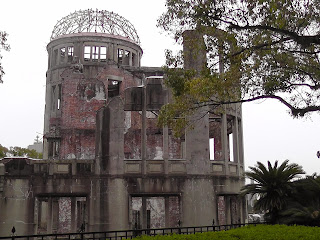It was cold and wet and grey when I arrived just before 11am. I got momentarily lost when I emerged from the cavernous underground shopping mall but was quickly on my way to the Atomic Dome memorial building. What struck me immediately about Hiroshima is how modern and vibrant the buildings are and how a city so completely laid waste by the "little boy" dropped by Enola Gay almost 70 years ago, has re-emerged as an example of the post war economic miracle that is Japan. Retaining the pre-war trolley car system is a nice touch.
I spent over 2 hours in the Atomic Peace museum fascinated and horrified in equal measure by the stories of those who survived and those who did not. The bits of clothing, the pocket watch frozen at 8:15, the time the bomb detonated, and the locks of hair that fell out when brushed and preserved by a distraught mother whose daughter died of radiation illness just a few days after the detonation.
To my mind what was glossed over, is why historically, Truman faced the decision he had to make back in the summer of 1945. The "fall" into war in 1941 is barely covered and responsibility for the outrageous aggression by Hirohito's troops both at Pearl Harbour and before in China and Korea, is never touched upon. Rather, there is an implication that the US chose to use the bomb to warn the Soviet Union at the end of the war to limit its expansionist policies; that it was somehow inappropriate for the Allies to insist on an unconditional surrender; that Japan was seeking through dialogue via the Russians, to bring about an end to the war.
No one can deny the sheer awfulness that befell the citizens of Hiroshima that beautiful sunny summer's day. I was deeply moved by the whole experience. However, as I sped back towards Kyoto this afternoon, I felt a little uneasy about the opportunity missed by the city which suffered so horribly, to acknowledge more honestly the reasons why the horror visited them that day.
 |
| The Atomic Dome in Hiroshima |
 |
| Hiroshima castle. Built in 1300s it was obliterated on 6 August 1945 and rebuilt in the late 1950s. |
 |
| Modern Hiroshima from Hiroshima castle |
 |
| The atomic peace dome from Hiroshima castle |


No comments:
Post a Comment